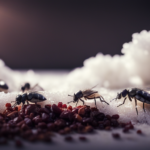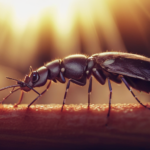Beginners Guides
What Are These Tiny Beetles In My House
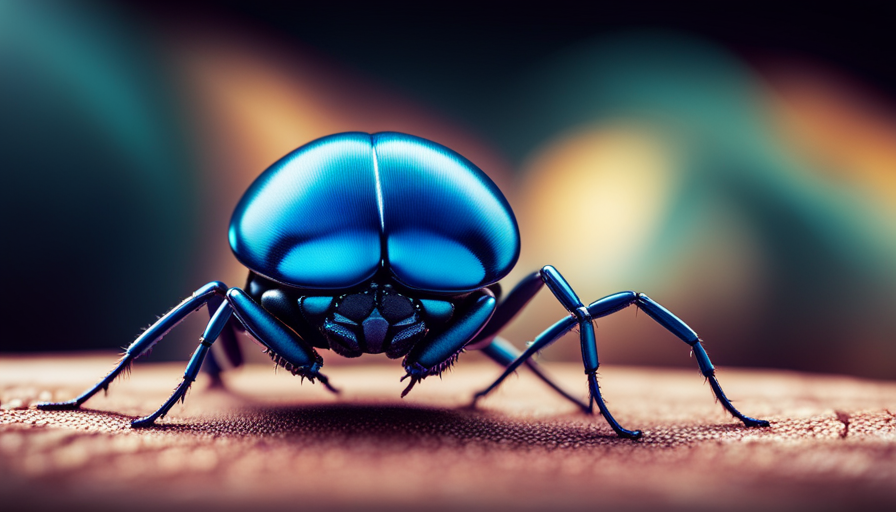
Have you ever entered your home only to find small beetles racing across your countertops or speeding over your floors? These tiny intruders can be a real bother, and recognizing them is a crucial step in tackling the problem effectively.
In this article, I will guide you through the process of identifying these tiny beetles, determining the cause of their infestation, and taking steps to eliminate them from your home.
Like unwelcome guests, these beetles can invade our living spaces without warning, leaving us scratching our heads in confusion. But fear not! With a little knowledge and some proactive measures, you can regain control of your home and bid farewell to these pesky intruders.
From natural remedies to chemical control methods, I will provide you with a range of options to choose from, allowing you to find the best solution for your specific situation.
So, let’s roll up our sleeves and get ready to tackle these tiny beetles head-on. Together, we can reclaim our homes and restore peace and tranquility to our living spaces.
Key Takeaways
- There are different types of beetles that can invade homes, such as carpet beetles, powderpost beetles, and drugstore beetles.
- Beetles can enter homes through cracks, gaps, and infested items, and they are attracted to warmth, moisture, and a food source.
- Regular cleaning, decluttering, and vacuuming can help eliminate beetles and reduce hiding spots.
- Sealing cracks and gaps in walls, windows, and doors, as well as using natural remedies and homemade traps, can help repel and catch beetles.
Identify the Type of Beetle
Have you ever wondered what those tiny beetles in your house are called? Well, let’s dive into the world of beetle biology and find out.
There are many types of beetles that can invade your home, but the most common ones include carpet beetles, powderpost beetles, and drugstore beetles.
Carpet beetles are small, oval-shaped insects that feed on natural fibers like wool and silk. They can often be found in closets, attics, and furniture.
Powderpost beetles, on the other hand, are notorious for infesting wooden structures. They lay their eggs in cracks and crevices of wood, which can cause extensive damage over time.
Lastly, drugstore beetles are attracted to stored food products, such as flour, spices, and dried fruits.
Signs of beetle infestation can vary depending on the type of beetle. Carpet beetles leave behind shed skins and fecal pellets, while powderpost beetles create small holes and sawdust-like frass. Drugstore beetles may leave behind chewed packaging and a distinct odor.
Now that we’ve identified the type of beetle, let’s move on to determining the cause of infestation.
Determine the Cause of Infestation
I will discuss the possible sources of infestation and the conditions that attract beetles to homes.
First, it’s important to note that beetles can enter homes through cracks, gaps, and open doors or windows. They can also be brought in through infested items such as firewood, furniture, or packaged food.
Secondly, beetles are attracted to homes that provide them with favorable conditions such as warmth, moisture, and a food source. This can include areas with dampness, decaying wood, food spills, or stored grains.
Possible sources of infestation
If you spot these tiny beetles in your house, chances are they may have hitched a ride from the great outdoors. These beetles have a life cycle that typically involves four stages: egg, larva, pupa, and adult. Signs of a beetle infestation can include finding dead or live beetles, shed skin, or holes in fabric or wood.
To get a better understanding of where these beetles might have come from, consider the following sub-lists:
-
Outdoor sources:
- Firewood: Beetles may have been hiding in the firewood you brought indoors.
- Flowers and plants: They might have entered your home through cut flowers or potted plants.
-
Indoor sources:
- Stored food: Infested food items can introduce beetles into your house.
- Cracks and crevices: Beetles can enter through tiny openings in walls, windows, or doors.
Understanding the possible sources of infestation will help you identify and address the conditions that attract beetles to homes.
Conditions that attract beetles to homes
Firewood and stored food can create conditions that attract beetles to homes. Beetles are attracted to the warmth and darkness of firewood piles, where they can lay eggs and find shelter. They are also drawn to stored food, such as grains, cereals, and pet food, which provide a source of nutrition for them. To better understand the conditions that attract beetles, consider the following table:
| Conditions That Attract Beetles | Ways to Prevent Beetle Infestation |
|---|---|
| Warm and dark environment | Store firewood away from the house |
| Presence of stored food | Keep food containers sealed tightly |
| Moisture | Fix any leaks or damp areas |
By addressing these conditions, you can significantly reduce the chances of attracting beetles to your home. Now, let’s transition into the next section about cleaning and decluttering your home to further prevent beetle infestations.
Clean and Declutter Your Home
Decluttering your home is an absolute must if you want to banish those pesky tiny beetles for good! These little pests thrive in cluttered environments, making it even more important to clean and organize your living space.
Start by focusing on cleaning tips that target areas where beetles are likely to hide. Vacuum regularly not only removes food debris that attracts beetles but also eliminates their eggs and larvae. Pay special attention to cracks and crevices, as beetles often seek refuge in these hard-to-reach places.
In addition to cleaning, implementing organizing strategies can help prevent beetle infestations. Store food in airtight containers to minimize access for beetles, and keep your pantry neat and tidy. Declutter your home also reduces the number of hiding spots for these tiny insects. Get rid of unused items, as they provide hiding places and breeding grounds. By creating a clean and organized environment, you’re taking proactive steps to deter beetles from entering your home in the first place.
Now that you’ve cleaned and decluttered, it’s time to seal entry points to ensure those beetles stay out for good.
Seal Entry Points
When it comes to keeping those pesky beetles out of my house, I know that inspecting and sealing any cracks and gaps in the walls, windows, and doors is essential. By doing so, I can prevent these tiny creatures from finding their way inside.
Additionally, using weatherstripping and door sweeps is another effective way to ensure that beetles don’t have a chance to enter through these entry points.
Inspect and seal cracks and gaps in walls, windows, and doors
Inspect your walls, windows, and doors for cracks and gaps, and seal them tightly to keep those pesky beetles out of your home. It’s important to address these entry points as they’re common areas for beetles to find their way inside.
Here are three sealant options to consider:
-
Silicone caulk: This versatile sealant is perfect for filling small cracks and gaps. It provides a durable and waterproof seal.
-
Expanding foam: Ideal for larger gaps, this foam expands to fill the space, creating a tight seal.
-
Weatherstripping tape: Use this tape to seal gaps around windows and doors. It’s easy to apply and provides an effective barrier against beetles.
By sealing cracks and gaps, you not only prevent beetle entry but also reduce the potential health risks associated with their presence. Once you’ve sealed these areas, it’s time to move on to the next step: using weatherstripping and door sweeps to further prevent beetle entry.
Use weatherstripping and door sweeps to prevent beetle entry
Inspecting and sealing cracks and gaps in walls, windows, and doors is a crucial step in preventing tiny beetles from entering your house. But there is another effective method to reinforce your defense against these unwelcome guests: using weatherstripping and door sweeps. Weatherstripping is a simple yet effective way to seal gaps around windows and doors, preventing both beetles and drafts from entering your home. It comes in various materials, such as adhesive-backed foam tape, V-strip, and door sweeps. Door sweeps, on the other hand, are specifically designed to block the gap at the bottom of a door, acting as a barrier against beetles. There are different types of door sweeps available, including brush sweeps, vinyl sweeps, and automatic door bottoms. By utilizing weatherstripping and door sweeps, you can significantly reduce the chances of beetles infiltrating your home. Transitioning into the subsequent section about ‘use natural remedies,’ it’s important to explore additional methods to combat these pests.
Use Natural Remedies
When it comes to repelling beetles in your house, there are a few natural remedies that can be effective. Essential oils such as peppermint, lavender, and tea tree have been known to repel beetles due to their strong scent. You can create a homemade spray by mixing a few drops of these oils with water and spraying it around entry points and infested areas.
Additionally, homemade traps and deterrents can also be effective in catching and deterring beetles.
Essential oils and herbs that repel beetles
Try sprinkling a few drops of peppermint oil around your house to keep those pesky beetles at bay – after all, an ounce of prevention’s worth a pound of cure! Using natural beetle repellents like essential oils and herbs not only helps to repel these unwanted pests but also brings additional benefits.
Here are three effective options to consider:
-
Lavender: Its strong scent repels beetles and leaves your house smelling fresh.
-
Neem oil: This powerful oil disrupts the beetle’s life cycle and acts as a deterrent.
-
Eucalyptus: Its aroma is disliked by beetles, making it an excellent natural repellent.
By incorporating these natural remedies into your pest control routine, you can effectively keep beetles out of your home without harsh chemicals. However, if you’re still struggling with an infestation, it’s time to explore homemade traps and deterrents to tackle the problem head-on.
Homemade traps and deterrents
To effectively combat the beetle infestation in your home, you can easily create homemade traps and deterrents that will help eliminate these pesky pests. Homemade remedies and natural alternatives can be just as effective as store-bought products, without the use of harsh chemicals.
One option is to make a simple beetle trap using a shallow dish filled with soapy water. Beetles are attracted to the scent of the soap and will drown when they land in the dish.
Another homemade deterrent is a mixture of vinegar and water sprayed onto surfaces where beetles are commonly found. The strong smell repels the insects, keeping them away from your home.
These homemade solutions are affordable, safe, and environmentally-friendly. However, if the infestation persists, it may be necessary to employ chemical control methods to completely eradicate the beetles from your house.
Employ Chemical Control Methods
When it comes to getting rid of beetles in my house, I’ve found that employing chemical control methods can be highly effective. Insecticides and pesticides specifically formulated for beetle elimination have proven to be quite successful in my experience. However, it’s crucial to always follow safety instructions and precautions when using these products to ensure the well-being of both myself and my household.
Insecticides and pesticides for beetle elimination
If you’re looking to banish those pesky beetles from your home, there’s a secret weapon that can swiftly send them packing – insecticides and pesticides. These powerful chemicals are designed to eliminate insects, including beetles, and can be an effective solution for beetle control.
However, it’s important to prioritize insecticide safety and choose organic pest control options whenever possible. Organic insecticides are derived from natural sources and are considered safer for humans, pets, and the environment.
When using any type of insecticide or pesticide, it’s crucial to carefully follow safety instructions and precautions. This includes wearing protective clothing, using the appropriate dosage, and storing the chemicals properly.
By taking these necessary precautions, you can effectively eliminate beetles from your home while ensuring the safety of your household.
Follow safety instructions and precautions
Ensure the safety of your loved ones by carefully following the instructions and precautions for using insecticides and pesticides. When dealing with these chemicals, it’s essential to take safety measures to protect yourself and your family.
First and foremost, always read and understand the product labels before use. Wear appropriate protective clothing, such as gloves and goggles, to shield your skin and eyes.
Additionally, ensure proper ventilation in the area where the insecticides or pesticides will be applied. Keep children and pets away from treated areas until they’ve completely dried.
It’s also crucial to consider health considerations, such as allergies or respiratory issues, when selecting and using these products.
By taking these safety precautions, you can effectively eliminate beetles while safeguarding your family’s well-being. Moving forward, it’s advisable to consult a pest control professional for further assistance.
Consult a Pest Control Professional
Hiring a pest control professional can help you identify and eliminate the tiny beetles in your house. These professionals have the expertise and knowledge to accurately identify the species of beetles and determine the most effective method of extermination. They will also be able to assess the extent of the infestation and provide you with valuable advice on preventing future infestations.
When you consult a pest control professional, they’ll first conduct a thorough inspection of your home to determine the signs of beetle infestation. This may include checking for small holes or tunnels in wooden furniture, finding beetle larvae or eggs, or identifying beetle droppings. By identifying these signs, they can then develop a targeted plan to eliminate the beetles and prevent further damage to your home.
In addition to eliminating the current infestation, a pest control professional can also provide you with helpful beetle prevention tips. This may include sealing cracks and crevices in your home, storing food properly, and keeping your home clean and clutter-free. By following these tips, you can greatly reduce the risk of future beetle infestations.
By consulting a pest control professional, you can effectively get rid of the tiny beetles in your house and prevent future infestations.
Prevent Future Infestations
Consulting a pest control professional can help you deal with the tiny beetles in your house, but it’s equally important to take preventive measures against future infestations. By implementing long-term strategies for beetle control, you can create an environment that’s less attractive to these pests.
One effective preventive measure is to keep your house clean and free of food debris. Beetles are attracted to crumbs and spills, so regularly sweeping and mopping your floors can go a long way in deterring them. Additionally, make sure to store food in sealed containers to prevent beetles from accessing it.
Another important step is to eliminate any moisture sources in your house. Beetles, like many other pests, are attracted to damp environments. Fixing leaks, improving ventilation, and using dehumidifiers can help reduce the moisture levels in your home, making it less appealing to beetles.
Furthermore, sealing any cracks or gaps in your walls, windows, and doors can prevent beetles from entering your house in the first place. These small openings can serve as entry points for beetles and other pests, so it’s crucial to seal them properly.
By taking these preventive measures, you can significantly reduce the likelihood of future beetle infestations. Now, let’s move on to the next section where we’ll discuss how to monitor and take action in case of any beetle sightings.
Monitor and Take Action
When it comes to beetle infestations in our homes, there are common concerns and queries that homeowners often have. People want to know what kind of beetles they’re dealing with and how to effectively get rid of them. As an expert, I can provide answers and advice to address these concerns. I offer homeowners solutions to monitor and take action against these tiny pests.
Common concerns and queries about beetle infestations
Worried about those tiny beetles in your house? You’re not alone. Beetle infestations can be a cause for concern, but understanding their behavior patterns and recognizing signs of beetle damage can help you address the issue.
Here are some common concerns and queries homeowners often have about beetle infestations:
- What are the potential risks of having beetles in my house?
- How can I identify the types of beetles in my home?
- Are these beetles harmful to humans or pets?
- What are the signs of beetle damage to look out for?
- How can I prevent future beetle infestations?
Knowing the answers to these questions can empower you to take appropriate action. Now, let’s delve into expert answers and advice for homeowners.
Expert answers and advice for homeowners
Fret not, homeowners! Let’s tap into the wisdom of the experts and unlock the treasure trove of advice to tackle the pesky beetle invaders in your humble abode.
When dealing with beetle infestations, it’s crucial to understand the beetle life cycle and be aware of the signs of infestation. Beetles go through four stages: egg, larva, pupa, and adult. Knowing this cycle helps in identifying the source of the problem and implementing effective control measures.
Look out for signs like tiny holes in wooden furniture, chewed fabric, or sawdust-like frass, which indicate beetle activity.
Regularly inspecting your home, maintaining cleanliness, and reducing moisture can prevent infestations. If the problem persists, it’s recommended to consult a professional pest control service to ensure proper eradication of these tiny pests.
Frequently Asked Questions
How long does it take for a beetle infestation to occur in a house?
To prevent beetle infestations in houses, regularly clean and declutter. Seal cracks and crevices, and store food in airtight containers. To effectively get rid of beetles, use insecticides or consult a professional pest control service.
Can these tiny beetles cause damage to furniture or belongings?
Yes, these tiny beetles can cause damage to furniture and belongings. It’s important to take preventive measures like sealing cracks and using natural ways to get rid of beetles, such as vinegar or cedar oil.
Are these tiny beetles harmful to humans or pets?
These tiny beetles can potentially pose health risks to humans and pets. It is important to take preventive measures to avoid any harm. Implementing proper cleaning and pest control methods can help keep them away.
How do I know if the infestation has been successfully eliminated?
To determine if the infestation has been successfully eliminated, look for signs such as a decrease in beetle activity, absence of live beetles, and no new damage. To prevent future infestations, maintain cleanliness, seal cracks, and use insecticides if necessary.
What are some common signs of a beetle infestation in a house?
Common signs of a beetle infestation in a house include seeing live or dead beetles, finding beetle larvae or eggs, noticing damage to wood or fabric, and hearing clicking sounds. To prevent infestations, keep your house clean, seal cracks and crevices, and eliminate moisture sources.
Conclusion
In conclusion, dealing with tiny beetles in your house can be a frustrating and annoying experience. However, by following the steps outlined in this article, you can successfully identify and eliminate these pesky pests.
Remember, knowledge is power, so take the time to educate yourself on the type of beetle you’re dealing with. With a little patience and persistence, you’ll be able to create a beetle-free living space that will have you feeling as light as a feather.
Hi, I’m Emma. I’m the Editor in Chief of Tiny House 43, a blog all about tiny houses. While tree houses are often associated with childhood, they can be the perfect adult retreat. They offer a cozy space to relax and unwind, surrounded by nature. And since they’re typically built on stilts or raised platforms, they offer stunning views that traditional homes simply can’t match. If you’re looking for a unique and romantic getaway, a tree house tiny house might just be the perfect option.
Beginners Guides
How Did the City of Fresno to Tiny House

As someone living in Fresno, I have always believed in the saying ‘home is where the heart is.’ Thanks to the city’s forward-thinking housing policies, even the smallest of homes can now have a place to call their own.
In this article, we’ll explore how Fresno has embraced the tiny house movement, collaborating with advocates and implementing innovative zoning regulations. Join me as we delve into the challenges faced and the remarkable progress made towards building a thriving tiny house community in Fresno.
Key Takeaways
- Fresno has implemented housing policies and initiatives aimed at increasing access to affordable housing, including energy-efficient homes and tiny house construction.
- Collaboration with tiny house advocates is crucial for effective housing solutions, as they bring valuable insights and innovative ideas to the table.
- Zoning regulations and permitting processes in Fresno are designed to engage the community and ensure that their needs and preferences are considered.
- Fresno has created innovative tiny house communities that focus on sustainability and affordability, incorporating features such as solar panels and rainwater harvesting systems.
The Shift in Housing Policies
I’m excited to talk about the changes happening in housing policies.
One of the most pressing issues in our society today is housing affordability. Many individuals and families struggle to find affordable housing options, causing financial strain and instability.
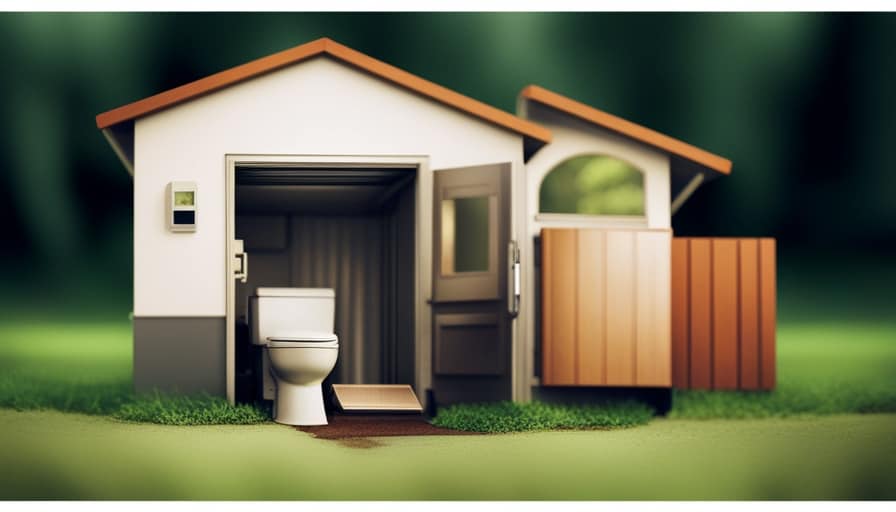
As a result, there’s been a shift in housing policies towards promoting sustainable living and increasing access to affordable housing. Governments and organizations are recognizing the importance of creating housing opportunities that are both environmentally friendly and economically viable.
This involves initiatives such as promoting energy-efficient homes, supporting the construction of tiny houses, and implementing rent control measures.
Collaborating With Tiny House Advocates
Collaborating with tiny house advocates has been crucial in implementing effective housing solutions in the city of Fresno. Through collaboration strategies and community engagement, we’ve been able to work hand in hand with advocates to address the unique challenges and opportunities that tiny houses present.
These collaborations have allowed us to tap into the knowledge and expertise of tiny house advocates, who bring valuable insights and innovative ideas to the table. We’ve engaged in open and transparent dialogues, fostering a sense of trust and understanding between all parties involved.

Zoning Regulations and Permitting Processes
Navigating the complexities of zoning regulations and permitting processes can be challenging, but it’s essential for ensuring the successful implementation of tiny house communities in the city of Fresno.
To streamline processes and make it easier for individuals and organizations to develop tiny house communities, the city of Fresno has taken steps to engage with the community and actively involve them in the decision-making process.
This includes hosting public meetings, soliciting feedback, and conducting thorough assessments of potential sites for tiny house communities. By involving the community in these processes, the city of Fresno can address any concerns or issues that may arise, while also ensuring that the needs and preferences of the community are taken into consideration.
This collaborative approach not only helps to build trust and support, but also allows for a more efficient and effective implementation of tiny house communities in the city.

Innovative Tiny House Communities in Fresno
One innovative approach to creating tiny house communities in Fresno is through the use of sustainable materials and renewable energy sources. These communities are designed with a focus on sustainability, incorporating features such as solar panels, rainwater harvesting systems, and energy-efficient appliances. By utilizing these sustainable practices, residents can reduce their carbon footprint and live in homes that are environmentally friendly.
Additionally, these communities aim to provide affordable living options for individuals who may not be able to afford traditional housing. Through the use of smaller, more efficient spaces, the cost of construction and maintenance is reduced, making it more accessible for those on a limited budget.
These innovative tiny house communities in Fresno are paving the way for sustainable housing and promoting affordable living for all.
Transitioning into the next section, let’s explore the challenges faced in building a tiny house movement.

Overcoming Challenges and Building a Tiny House Movement
Confronting obstacles and working together, we can create a thriving tiny house movement in Fresno.
To overcome challenges and build a sustainable and affordable housing solution, we must first address zoning regulations. Currently, many cities have restrictions that make it difficult to build tiny houses on a permanent foundation. By advocating for changes in zoning laws, we can create more opportunities for tiny house communities.
Additionally, we need to address financing options for individuals interested in building tiny houses. Traditional lending institutions may not provide loans for these unconventional homes, so alternative financing options must be explored. Collaborating with local government, community organizations, and financial institutions can help us develop innovative solutions to overcome these challenges.
Frequently Asked Questions
How Long Does It Typically Take to Build a Tiny House?
Typically, it takes around 2-4 months to build a tiny house. The building timeline can vary based on factors like design complexity, availability of materials, and contractor availability. Cost considerations include materials, labor, and permits.
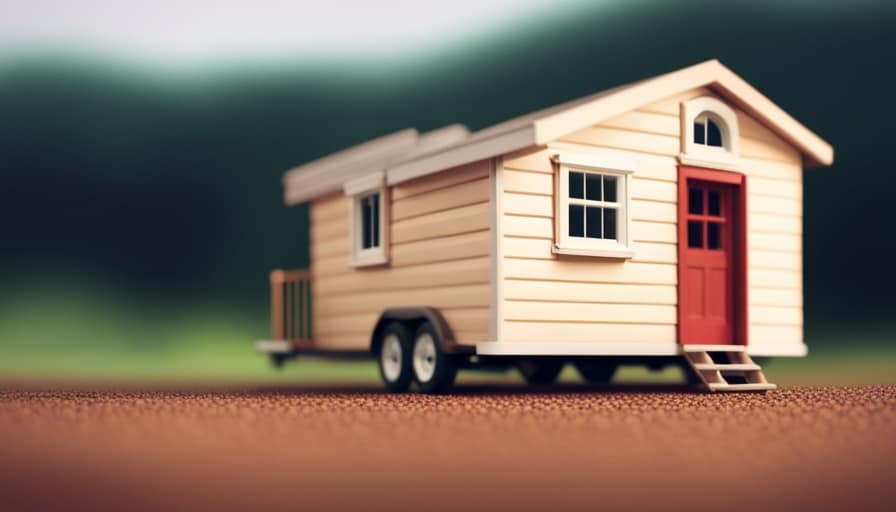
Are There Any Specific Requirements for the Size or Design of a Tiny House in Fresno?
In Fresno, specific requirements exist for the size and design of tiny houses. The city has set guidelines to ensure safety and conformity. Meeting these requirements is crucial to obtaining necessary permits and building a legally compliant tiny house.
Can I Legally Live in a Tiny House on Wheels in Fresno?
Yes, you can legally live in a tiny house on wheels in Fresno. While specific regulations may vary, other cities have implemented tiny house regulations with benefits such as affordability, sustainability, and minimal environmental impact.
How Can I Find Resources and Support for Building My Own Tiny House in Fresno?
Finding local workshops and connecting with tiny house builders in Fresno is crucial for building my own tiny house. Through thorough research and analytical thinking, I can discover resources and support to ensure a successful project.
Are There Any Financial Incentives or Grants Available for Individuals Interested in Building a Tiny House in Fresno?
There are financial assistance programs and grants available for individuals interested in building a tiny house in Fresno. It’s important to familiarize yourself with the building regulations and requirements to ensure compliance.

Conclusion
In conclusion, the city of Fresno has successfully embraced the tiny house movement through a shift in housing policies, collaboration with advocates, and innovative communities.
The zoning regulations and permitting processes have been streamlined to accommodate tiny house living. Despite challenges, the city has built a strong foundation for the tiny house movement to thrive.
As the saying goes, "The journey of a thousand miles begins with a single step," and Fresno has taken that step towards a more sustainable and affordable housing solution.
I’m Theodore, and I love tiny houses. In fact, I’m the author of Tiny House 43, a book about tiny houses that are also tree houses. I think they’re magical places where imaginations can run wild and adventures are just waiting to happen.
While tree houses are often associated with childhood, they can be the perfect adult retreat. They offer a cozy space to relax and unwind, surrounded by nature. And since they’re typically built on stilts or raised platforms, they offer stunning views that traditional homes simply can’t match.
If you’re looking for a unique and romantic getaway, a tree house tiny house might just be the perfect option.
Beginners Guides
How Do I Get Rid of Tiny Black Flies in My House

- Health risks associated with tiny black flies in the house
- Effective methods to prevent and control the presence of black flies in homes or gardens
I have tried every possible solution, but those annoying tiny black flies refuse to leave my house!
If you’re dealing with the same frustrating problem, don’t worry – I’ve got you covered.
In this article, I’ll share my expert knowledge on identifying these pesky bugs, understanding the causes of their infestations, and provide you with both natural and chemical remedies to banish them for good.
Say goodbye to those annoying flies and hello to a fly-free home!

Key Takeaways
- Identify and eliminate breeding grounds by removing standing water and damp areas.
- Use natural remedies like homemade fly traps with apple cider vinegar and essential oils to repel flies.
- Consider using chemical treatments designed to kill black flies, following the instructions carefully.
- Take preventive measures to keep your house clean and free from food or organic debris to prevent future infestations.
Identifying the Tiny Black Flies
I can use a magnifying glass to examine the tiny black flies and determine their species. When it comes to differentiating between fruit flies and black flies, there are a few key characteristics to look out for.
Fruit flies are usually smaller in size, about 1/8 of an inch long, and have a tan or yellowish body with red eyes. On the other hand, black flies are slightly larger, measuring around 1/4 of an inch, and have a dark black or grayish body with dark wings.
Now, let’s move on to controlling and eliminating black flies in outdoor spaces. One effective method is to eliminate their breeding grounds by removing any standing water or damp areas where they can lay their eggs. Regularly emptying and cleaning birdbaths, flower pots, and gutters can help prevent black fly infestations.
Additionally, using insect repellents or installing fine mesh screens on doors and windows can provide some protection against these pesky pests.

Understanding the Causes of Black Fly Infestations
To understand the causes of black fly infestations, we need to examine their preferred breeding sites and environmental conditions. These tiny pests thrive in moist and decaying organic matter, making the following places common breeding grounds for black flies:
-
Standing water: Black flies lay their eggs in standing water, such as ponds, lakes, and even puddles. It’s crucial to eliminate any stagnant water sources around your house to prevent infestations.
-
Overgrown vegetation: Black flies are attracted to dense vegetation, especially if it’s near water bodies. Trim shrubs, mow your lawn regularly, and remove any overgrown plants to discourage black flies from breeding.
-
Moist organic matter: Black flies lay their eggs in decomposing leaves, grass clippings, and other organic debris. Keep your yard clean and free of debris to reduce the likelihood of black fly infestations.
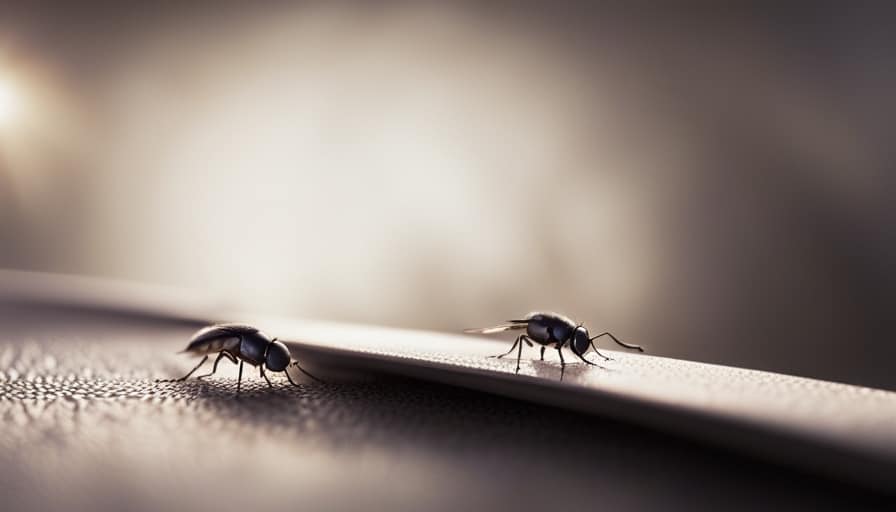
Understanding these common breeding grounds can help you identify and eliminate the causes of black fly infestations, keeping your home fly-free and comfortable.
Natural Remedies to Eliminate Tiny Black Flies
With a combination of proper sanitation and natural remedies, you can effectively eliminate tiny black flies from your house. One effective natural remedy is making homemade fly traps. These traps can be made using common household items such as apple cider vinegar, dish soap, and a plastic bottle. Simply cut the bottle in half, pour a mixture of apple cider vinegar and dish soap into the bottom half, and place the top half of the bottle inverted into the bottom half. The flies will be attracted to the scent of the vinegar, but the dish soap will prevent them from escaping. Another natural remedy is using essential oils for fly control. Oils such as lavender, peppermint, and eucalyptus have strong scents that repel flies. Simply mix a few drops of your chosen oil with water and spray it around areas where flies are present. By incorporating these natural remedies into your fly control routine, you can effectively get rid of tiny black flies in your house.
| Homemade Fly Traps | Essential Oils for Fly Control |
|---|---|
| – Apple cider vinegar and dish soap mixture in a plastic bottle | – Lavender, peppermint, and eucalyptus oils |
| – Flies are attracted to the vinegar scent but trapped by the soap | – Mix a few drops with water and spray in affected areas |
| – Simple and cost-effective solution | – Oils have strong scents that repel flies |
| – Dispose of trapped flies regularly | – Repeat application as needed |
Chemical Treatments for Getting Rid of Black Flies
By using chemical treatments, you can effectively eliminate black flies from your house. Here are three options to consider:
-
Chemical insecticides: These products are specifically designed to kill insects, including black flies. Look for insecticides that are labeled for use against flies and follow the instructions carefully. Apply the insecticide in areas where black flies are commonly found, such as around windows, doors, and other entry points.

-
Fly traps: There are chemical-based fly traps available that attract and capture black flies. These traps use a combination of chemicals and pheromones to lure the flies in and prevent them from escaping. Place the traps in areas where black flies are present, such as near garbage cans or in the kitchen.
-
Professional exterminator: If you’re dealing with a severe infestation or if chemical treatments haven’t been effective, it may be best to call a professional exterminator. They have access to stronger chemicals and can provide a targeted approach to eliminate black flies from your house.
Remember to always read and follow the instructions on chemical insecticides and traps, and consider the help of a professional if needed.
Preventing Future Infestations of Tiny Black Flies
My best advice for preventing future infestations of tiny black flies in my house is to maintain proper sanitation and eliminate potential breeding grounds.

To maintain a fly-free environment, it’s important to keep your house clean and free from any food or organic debris. Make sure to regularly clean your kitchen, especially the countertops, sinks, and garbage disposal areas. Keep all food stored in airtight containers and promptly clean up any spills or crumbs.
Additionally, it’s crucial to identify and eliminate common breeding grounds for black flies in homes. These include standing water, damp areas, and overwatered plants. Regularly check for any leaks or moisture issues and fix them promptly.
Frequently Asked Questions
Can These Tiny Black Flies Harm Humans or Pets?
I’m not an expert, but I can share that tiny black flies in the house might be annoying, but they usually don’t harm humans or pets. It’s always a good idea to take preventive measures to control their presence.
Are There Any Specific Regions or Climates Where These Black Flies Are More Common?
In certain regions and climates, these pesky black flies tend to be more common. Understanding their preferences can help in devising effective strategies to keep them at bay.

Can These Tiny Black Flies Cause Damage to Plants or Food?
Yes, these tiny black flies can cause damage to indoor plants as they lay their eggs in the soil. They can also contaminate stored food by landing on it and leaving behind bacteria.
How Long Does It Usually Take for Natural Remedies to Effectively Eliminate Black Flies?
On average, natural remedies can effectively eliminate black flies within a few days. However, the exact time may vary depending on the severity of the infestation and the specific remedies used.
Are There Any DIY Traps or Baits That Can Be Used to Catch and Eliminate These Tiny Black Flies?
There are several DIY fly traps and effective baits that can be used to catch and eliminate those pesky tiny black flies. Let me share some knowledge and details on how you can tackle this issue.
Conclusion
So there you have it, a plethora of methods to bid farewell to those pesky tiny black flies that have invaded your humble abode.

From natural remedies to chemical treatments, we’ve covered it all.
Now, armed with this knowledge, you can take control of your home and ensure these unwelcome guests never return.
Happy fly-free living!
I’m Theodore, and I love tiny houses. In fact, I’m the author of Tiny House 43, a book about tiny houses that are also tree houses. I think they’re magical places where imaginations can run wild and adventures are just waiting to happen.
While tree houses are often associated with childhood, they can be the perfect adult retreat. They offer a cozy space to relax and unwind, surrounded by nature. And since they’re typically built on stilts or raised platforms, they offer stunning views that traditional homes simply can’t match.
If you’re looking for a unique and romantic getaway, a tree house tiny house might just be the perfect option.
Beginners Guides
How Do I Get Rid of Tiny Bugs in My House

I have pests in my home that are causing me frustration! They are like small intruders that are appearing all over the place. However, do not worry, as I have conducted thorough research and found effective solutions to eliminate these bothersome pests.
In this article, I’ll guide you through identifying the types of bugs, understanding the causes of infestations, and providing natural and chemical remedies to eliminate them.
Say goodbye to those unwelcome guests and hello to a bug-free home!
Key Takeaways
- Identifying the specific pest by observing droppings or behavior is crucial in getting rid of tiny bugs in the house.
- Proper sanitation practices, such as keeping the kitchen and dining areas clean, are important in preventing bug infestations.
- Natural remedies like herbal insecticides and essential oils can be effective in deterring bugs without the use of harsh chemicals.
- Regular cleaning, sealing cracks, and maintaining a tidy home are essential in preventing future bug infestations.
Identifying the Types of Tiny Bugs in Your House
I can easily identify the types of tiny bugs in my house by observing their physical characteristics and behavior. One of the most common signs of an infestation is the presence of droppings or excrement. Different types of bugs leave different types of droppings, which can help determine the specific pest in your house.

Additionally, observing the behavior of the bugs can provide valuable information. Some bugs are more active during the day, while others are nocturnal. Some bugs may prefer certain areas of the house, such as the kitchen or bathroom.
If you’re unsure about the type of bug in your house, it’s advisable to consult with professional exterminators who’ve the expertise to accurately identify and eliminate the pests.
Understanding the Common Causes of Bug Infestations
One of the most common causes of bug infestations is a lack of proper sanitation practices in the home. Understanding bug behavior and knowing their common household bug habitats can help prevent infestations.
Bugs are attracted to food sources, so it’s important to keep the kitchen and dining areas clean and free of crumbs and spills. Regularly emptying and cleaning garbage cans can also deter bugs from entering the home.

Additionally, bugs thrive in warm and moist environments, so it’s important to fix any leaks or damp areas in the house. Cluttered spaces provide hiding spots for bugs, so keeping the home organized and decluttered can help minimize their presence.
Natural Remedies to Get Rid of Tiny Bugs in Your House
To effectively eliminate tiny bugs in your house, try using natural remedies with ingredients such as vinegar and essential oils. Natural remedies are a great option for those who prefer non-toxic solutions and want to avoid harsh chemicals.
One effective natural remedy is using herbal insecticides. These insecticides are made from plant-based ingredients and can be sprayed in areas where bugs are commonly found, such as corners, cracks, and crevices.
Another natural remedy to consider is essential oils. Certain essential oils, such as peppermint, lavender, and tea tree oil, have insect-repellent properties. Simply mix a few drops of the essential oil with water and spray it around your house to deter bugs.

These natural remedies can be a safe and effective way to get rid of tiny bugs in your house.
Chemical Treatments for Eliminating Tiny Bugs
There are several effective chemical treatments available to eliminate tiny bugs in your house. When it comes to pest control methods, using insecticides is a common and efficient approach. There are various types of insecticides on the market, each with its own advantages and disadvantages.
It’s important to compare different insecticides to determine which one is best suited for your needs. Some insecticides target specific bugs, while others have a broad spectrum of effectiveness. Additionally, consider the application method and the duration of effectiveness. Some insecticides require direct contact with the bugs, while others can be used as a residual treatment.
It’s also essential to follow the safety instructions provided by the manufacturer when using chemical treatments to ensure the well-being of both humans and pets in your home.

Preventing Future Bug Infestations in Your Home
I’ll make sure to regularly clean and seal any cracks in my house to keep bugs from coming in. Effective cleaning techniques are crucial in preventing bug infestations and creating a bug-free environment. Maintaining a clean and tidy home is essential to minimize the presence of bugs. Regularly vacuuming carpets and upholstery, sweeping and mopping floors, and wiping down surfaces will help eliminate any crumbs or food particles that may attract bugs. Additionally, proper food storage is essential to prevent bugs from being attracted to your kitchen. Keeping food in sealed containers and promptly cleaning up spills or crumbs will deter bugs from entering your home. Regularly inspecting and repairing any cracks or gaps in windows, doors, and walls will also help prevent bugs from finding their way inside.
| Cleaning Techniques | Maintenance Tips |
|---|---|
| Vacuum carpets and upholstery | Inspect and repair cracks or gaps |
| Sweep and mop floors | Properly store food to deter bugs |
| Wipe down surfaces | Regularly clean and seal cracks |
| Dispose of trash regularly | Keep a tidy and clutter-free home |
Frequently Asked Questions
Can These Tiny Bugs Cause Any Harm to Humans or Pets?
I’m not sure about the specific bugs in your house, but some tiny bugs can cause harm to humans or pets. It’s important to address the bug infestation promptly to protect your health and take preventive measures to keep them out.
How Long Does It Typically Take for Natural Remedies to Effectively Get Rid of Tiny Bugs?
It typically takes a few weeks for natural remedies to effectively eliminate tiny bugs. However, it’s important to note that results may vary. As for side effects, natural remedies are generally safe for humans and pets.
What Are Some Signs That Indicate a Bug Infestation in the House?
Signs of a bug infestation in the house include seeing live or dead bugs, finding their droppings or eggs, and noticing damage to furniture or walls. Preventing bug infestations involves keeping a clean and tidy home, sealing entry points, and using insect repellents.

Are There Any Specific Areas in the House Where These Tiny Bugs Are Commonly Found?
In my experience, tiny bugs tend to hide in common areas like kitchen cabinets, bathrooms, and near windows. To prevent them, I recommend regular cleaning, sealing cracks, and keeping food stored properly.
Can Certain Weather Conditions or Changes in the Environment Attract These Tiny Bugs Into the House?
Certain weather conditions or changes in the environment can attract these tiny bugs into the house. Factors like warm and humid weather, open windows, and presence of organic matter can make your home more inviting for them.
Conclusion
In conclusion, while it can be frustrating to deal with tiny bugs in your house, there are effective ways to get rid of them.
By identifying the types of bugs and understanding the common causes of infestations, you can take natural or chemical treatments to eliminate them.

Additionally, taking preventive measures can help to avoid future bug infestations.
Remember, with the right knowledge and strategies, you can create a bug-free environment in your home.
I’m Theodore, and I love tiny houses. In fact, I’m the author of Tiny House 43, a book about tiny houses that are also tree houses. I think they’re magical places where imaginations can run wild and adventures are just waiting to happen.
While tree houses are often associated with childhood, they can be the perfect adult retreat. They offer a cozy space to relax and unwind, surrounded by nature. And since they’re typically built on stilts or raised platforms, they offer stunning views that traditional homes simply can’t match.
If you’re looking for a unique and romantic getaway, a tree house tiny house might just be the perfect option.
-

 Beginners Guides2 weeks ago
Beginners Guides2 weeks agoHow To Buy A Tesla Tiny House
-

 Energy Efficiency2 months ago
Energy Efficiency2 months agoBest Tiny Homes For Cold Climates
-

 Beginners Guides1 week ago
Beginners Guides1 week agoTiny House Nation Where Are They Now Stephanie
-

 Tiny House Resources (e.g., legalities, cost, insurance, FAQs)2 months ago
Tiny House Resources (e.g., legalities, cost, insurance, FAQs)2 months agoDo Tiny Homes Need Planning Permission?
-

 Beginners Guides3 weeks ago
Beginners Guides3 weeks agoFrom The Show Tiny House Nation How Many Keep Their Tiny House?
-

 Beginners Guides2 months ago
Beginners Guides2 months agoUsing a Climbing Net For Treehouse Construction
-

 Beginners Guides2 months ago
Beginners Guides2 months agoHow to Build a Treehouse Without Drilling Into the Tree
-

 Beginners Guides3 weeks ago
Beginners Guides3 weeks agoTiny House Nation Who Pays For The Houses






